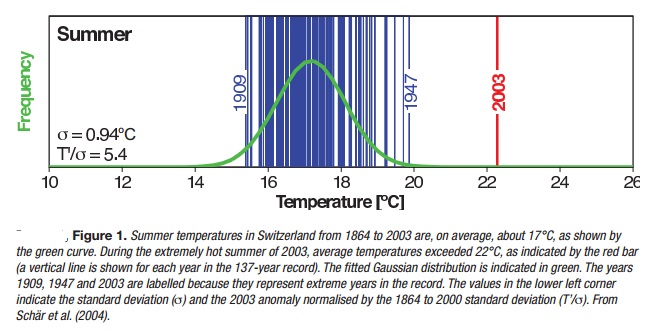Chapter: social science geography student essay
Can Individual Extreme Events be Explained by Greenhouse Warming?

Can Individual Extreme
Events be Explained by Greenhouse Warming?
Changes in climate extremes are expected as the climate warms
in response to increasing atmospheric greenhouse gases resulting from human
activities, such as the use of fossil fuels. However, determining whether a
specific, single extreme event is due to a specific cause, such as increasing
greenhouse gases, is difficult, if not impossible, for two reasons: 1) extreme
events are usually caused by a combination of factors and 2) a wide range of
extreme events is a normal occurrence even in an unchanging climate. Nevertheless,
analysis of the warming observed over the past century suggests that the
likelihood of some extreme events, such as heat waves, has increased due to
greenhouse warming, and that the likelihood of others, such as frost or
extremely cold nights, has decreased. For example, a recent study estimates
that human influences have more than doubled the risk of a very hot European
summer like that of 2003.
People affected by an extreme weather event often ask whether
human influences on the climate could be held to some extent responsible.
Recent years have seen many extreme events that some commentators have linked
to increasing greenhouse gases. These include the prolonged drought in
Australia, the extremely hot summer in Europe in 2003 (see Figure 1), the
intense North Atlantic hurricane seasons of 2004 and 2005 and the extreme
rainfall events in Mumbai, India in July 2005. Could a human influence such as
increased concentrations of greenhouse gases in the atmosphere have 'caused'
any of these events?
Extreme events usually result from a combination of factors.
For example, several factors contributed to the extremely hot European summer
of 2003, including a persistent highpressure system that was associated with
very clear skies and dry soil, which left more solar energy available to heat
the land because less energy was consumed to evaporate moisture from the soil.
Similarly, the formation of a hurricane requires warm sea surface temperatures
and specific atmospheric circulation conditions. Because some factors may be
strongly affected by human activities, such as sea surface temperatures, but
others may not, it is not simple to detect a human influence on a single,
specific extreme event.
Nevertheless, it may be possible to use climate models to
determine whether human influences have changed the likelihood of certain types
of extreme events. For example, in the case of the 2003 European heat wave, a
climate model was run including only historical changes in natural factors that
affect the climate, such as volcanic activity and changes in solar output.
Next, the model was run again including both human and natural factors, which
produced a simulation of the evolution of the European climate that was much
closer to that which had actually occurred. Based on these experiments, it was
estimated that over the 20th century, human influences more than doubled the
risk of having a summer in Europe as hot as that of 2003, and that in the
absence of human influences, the risk would probably have been one in many hundred
years. More detailed modelling work will be required to estimate the change in
risk for specific high-impact events, such as the occurrence of a series of
very warm nights in an urban area such as Paris.
The value of such a probability-based approach - 'Does human
influence change the likelihood of an event?' - is that it can be used to
estimate the influence of external factors, such as increases in greenhouse
gases, on the frequency of specific types of events, such as heat waves or
frost. Nevertheless, careful statistical analyses are required, since the
likelihood of individual extremes, such as a late-spring frost, could change
due to changes in climate variability as well as changes in average climate
conditions. Such analyses rely on climate-model based estimates of climate
variability, and thus the climate models used should adequately represent that
variability.
The same likelihood-based approach can be used to examine
changes in the frequency of heavy rainfall or floods. Climate models predict
that human influences will cause an increase in many types of extreme events,
including extreme rainfall. There is already evidence that, in recent decades,
extreme rainfall has increased in some regions, leading to an increase in
flooding.
Related Topics